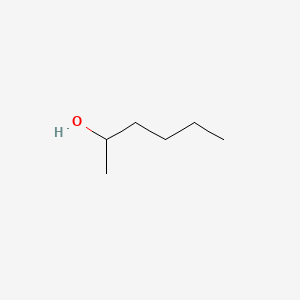| MeSH term | MeSH ID | Detail |
|---|---|---|
| Body Weight | D001835 | 333 associated lipids |
| Occupational Diseases | D009784 | 42 associated lipids |
| Peripheral Nervous System Diseases | D010523 | 33 associated lipids |
| Retrograde Degeneration | D012183 | 4 associated lipids |
2-hexanol
2-hexanol is a lipid of Fatty Acyls (FA) class. 2-hexanol often locates in Clone. The associated genes with 2-hexanol are PDC gene. The related lipids are 2-hexanol and 1-Octanol.
Cross Reference
Introduction
To understand associated biological information of 2-hexanol, we collected biological information of abnormalities, associated pathways, cellular/molecular locations, biological functions, related genes/proteins, lipids and common seen animal/experimental models with organized paragraphs from literatures.
What diseases are associated with 2-hexanol?
There are no associated biomedical information in the current reference collection.
Possible diseases from mapped MeSH terms on references
We collected disease MeSH terms mapped to the references associated with 2-hexanol
PubChem Associated disorders and diseases
What pathways are associated with 2-hexanol
There are no associated biomedical information in the current reference collection.
PubChem Biomolecular Interactions and Pathways
Link to PubChem Biomolecular Interactions and PathwaysWhat cellular locations are associated with 2-hexanol?
Visualization in cellular structure
Associated locations are in red color. Not associated locations are in black.
Related references are published most in these journals:
| Location | Cross reference | Weighted score | Related literatures |
|---|
What functions are associated with 2-hexanol?
There are no associated biomedical information in the current reference collection.
What lipids are associated with 2-hexanol?
Related references are published most in these journals:
| Lipid concept | Cross reference | Weighted score | Related literatures |
|---|
What genes are associated with 2-hexanol?
Related references are published most in these journals:
| Gene | Cross reference | Weighted score | Related literatures |
|---|
What common seen animal models are associated with 2-hexanol?
There are no associated biomedical information in the current reference collection.
NCBI Entrez Crosslinks
All references with 2-hexanol
Download all related citations| Authors | Title | Published | Journal | PubMed Link |
|---|---|---|---|---|
| Iwata M et al. | Changes of n-hexane metabolites in urine of rats exposed to various concentrations of n-hexane and to its mixture with toluene or MEK. | 1983 | Int Arch Occup Environ Health | pmid:6654498 |
| OromÃ-Farrús M et al. | Acylation of Chiral Alcohols: A Simple Procedure for Chiral GC Analysis. | 2012 | J Anal Methods Chem | pmid:22649749 |
| Wang G et al. | Two new phenylpropanoids and one propanoate from Morinda citrifolia. | 2011 | J Asian Nat Prod Res | pmid:21409685 |
| Singh N and Dureja P | Persistence of hexaconazole, a triazole fungicide in soils. | 2000 | J Environ Sci Health B | pmid:10968606 |
| Governa M et al. | Urinary excretion of 2,5-hexanedione and peripheral polyneuropathies workers exposed to hexane. | 1987 | J Toxicol Environ Health | pmid:3029393 |
| Prokofjevs A et al. | Borenium ion catalyzed hydroboration of alkenes with N-heterocyclic carbene-boranes. | 2012 | J. Am. Chem. Soc. | pmid:22713106 |
| Onaca C et al. | Degradation of alkyl methyl ketones by Pseudomonas veronii MEK700. | 2007 | J. Bacteriol. | pmid:17351032 |
| Tsai HJ and Chou SY | A novel hydroxyfuroic acid compound as an insulin receptor activator. Structure and activity relationship of a prenylindole moiety to insulin receptor activation. | 2009 | J. Biomed. Sci. | pmid:19642985 |
| Sakura M et al. | Olfactory discrimination of structurally similar alcohols by cockroaches. | 2002 | J. Comp. Physiol. A Neuroethol. Sens. Neural. Behav. Physiol. | pmid:12466954 |
| Veronesi B et al. | Ultrastructural studies of the dying-back process. VI. Examination of nerve fibers undergoing giant axonal degeneration in organotypic culture. | 1983 | J. Neuropathol. Exp. Neurol. | pmid:6827287 |
| Pscheidt B and Glieder A | Yeast cell factories for fine chemical and API production. | 2008 | Microb. Cell Fact. | pmid:18684335 |
| Toftgård R et al. | Xylene induces a cytochrome P-450 isozyme in rat liver similar to the major isozyme induced by phenobarbital. | 1983 | Mol. Pharmacol. | pmid:6865901 |
| Mortensen B et al. | Comparison and in vivo relevance of two different in vitro head space metabolic systems: liver S9 and liver slices. | 1997 | Pharmacol. Toxicol. | pmid:9258983 |
| Chaput MA | Respiratory-phase-related coding of olfactory information in the olfactory bulb of awake freely-breathing rabbits. | 1986 | Physiol. Behav. | pmid:3961008 |
| Gomi K et al. | Epoxide hydrolase: a mRNA induced by the fungal pathogen Alternaria alternata on rough lemon (Citrus jambhiri Lush). | 2003 | Plant Mol. Biol. | pmid:14756316 |
| Thompson AC et al. | Identification and quantitative analysis of the volatile substances emitted by maturing cotton in the field. | 1971 | Plant Physiol. | pmid:16657733 |
| Guerrieri F et al. | Perceptual and neural olfactory similarity in honeybees. | 2005 | PLoS Biol. | pmid:15736975 |
| Misumi J et al. | [An experimental study on the neurotoxicity of 2-octanone and 2-hexanol, a metabolite of n-hexane]. | 1982 | Sangyo Igaku | pmid:6296504 |
| Granvil CP et al. | Metabolic fate of methyl n-butyl ketone, methyl isobutyl ketone and their metabolites in mice. | 1994 | Toxicol. Lett. | pmid:8284793 |
